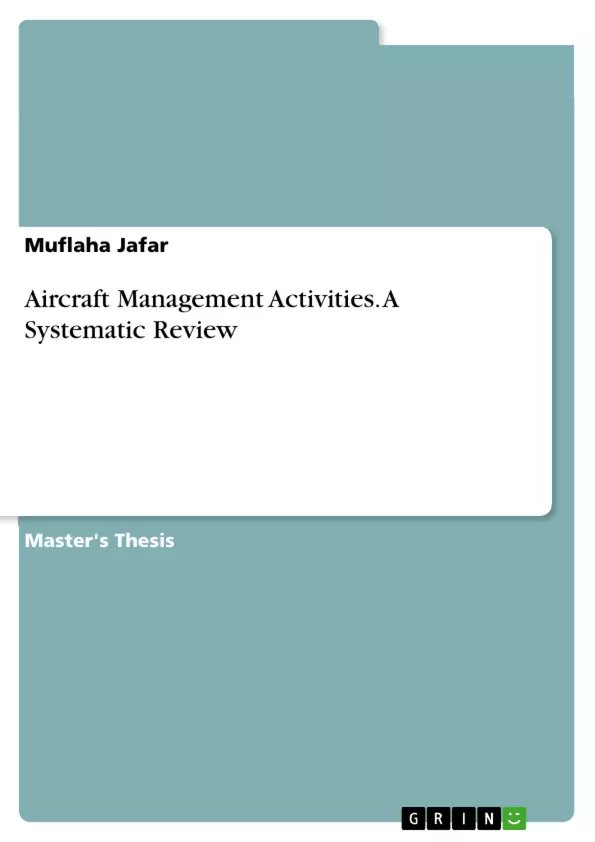This systematic review seeks to answer the questions regarding the development process, efficiency, issues and trends in the application of aircraft maintenance and management approaches. With ongoing changes in regulatory requirements, technological development and cost control remaining critical issues for the aviation industry, it is therefore imperative to gain an appreciation of the evolution of maintenance practices. The review is based on the collection of secondary qualitative articles from various peer-reviewed papers and industry reports starting from the year 2000 The main themes explored in the review include historical overview, change from reactive to proactive maintenance techniques, preventive, predictive and condition based maintenance techniques and strategies. The work shows that there is a rather sharp shift from what the authors call the reactive maintenance paradigm, where the primary objective is to repair failed assets, to the so-called smart maintenance, which is based on the use of big data and analytics, AI, robotics, digital twins, and the like. Among new effective methodologies we can single out predictive and condition-based maintenance, which, taking advantage of real-time data analytics and sensor technologies, proved their effectiveness in terms of reducing the time spent on failures, costs, and increasing safety in comparison with previous methods.
Inhaltsverzeichnis (Table of Contents)
- CHAPTER 1: INTRODUCTION
- 1.1 Introduction
- 1.2 Background
- 1.3 Problem Statement
- 1.4 Rationale of the Research
- 1.5 Aim
- 1.6 Objectives
- 1.7 Research Questions
- 1.8 Significance of the Research
- 1.9 Researcher Location
- 1.10 Dissertation Structure
- 1.11 Summary of the Chapter
- CHAPTER 2: LITERATURE REVIEW
- 2.1 Introduction
- 2.2 Historical Development of Aircraft Maintenance
- 2.3 Current Practices in Aircraft Maintenance and Management
- 2.3.1 Preventive Maintenance
- 2.3.2 Predictive Maintenance
- 2.3.3 Condition-Based Maintenance
- 2.4 Challenges in Aircraft Maintenance and Management
- 2.4.1 Regulatory Compliance
- 2.4.2 Technological Advancements
- 2.4.3 Cost Constraints
- 2.4.4 Skilled Labor Shortage
- 2.5 Innovative Solutions in Aircraft Maintenance and Management
- 2.5.1 Artificial Intelligence and Machine Learning
- 2.5.2 Robotics and Automation
- 2.5.3 Advanced Data Analytics
- 2.6 Future Trends in Aircraft Maintenance and Management
- 2.6.1 Digital Twins
- 2.6.2 Blockchain Technology
- 2.6.3 Augmented Reality
- 2.7 Summary of the Chapter
- CHAPTER 3: RESEARCH METHODOLOGY
- 3.1 Introduction
- 3.2 Research Onion
- 3.3 Research Philosophy
- 3.4 Methodological Choice
- 3.5 Research Strategy
- 3.6 Data Collection Method
- 3.7 Data Analysis Tools and Techniques
- 3.8 Ethical Considerations
- 3.9 Validity and Reliability
- 3.10 Summary
- CHAPTER 4: DATA ANALYSIS, INTERPRETATION AND DISCUSSION
- 4.1 Analysis of the Secondary-qualitative Data
- 4.1.1 Evolution of Maintenance Strategies
- 4.1.2 Effectiveness of Maintenance Strategies
- 4.1.3 Challenges in Aircraft Maintenance
- 4.1.4 Innovative Solutions
- 4.1 Analysis of the Secondary-qualitative Data
- CHAPTER 5: DISCUSSION
Zielsetzung und Themenschwerpunkte (Objectives and Key Themes)
This systematic review aims to investigate the development process, efficiency, challenges, and trends in aircraft maintenance and management approaches. It explores the evolution of maintenance practices in response to changing regulations, technological advancements, and cost control pressures within the aviation industry.
- Historical overview of aircraft maintenance practices.
- Transition from reactive to proactive maintenance techniques.
- Examination of preventive, predictive, and condition-based maintenance strategies.
- Analysis of challenges related to implementing advanced maintenance approaches.
- Exploration of innovative solutions, including AI, robotics, and blockchain technology.
Zusammenfassung der Kapitel (Chapter Summaries)
Chapter 1: Introduction introduces the research, its rationale, aims, objectives, and structure. Chapter 2: Literature Review provides a historical overview of aircraft maintenance, explores current practices (preventive, predictive, and condition-based maintenance), examines related challenges (regulatory, technological, cost, and labor), and discusses innovative solutions (AI, robotics, data analytics).
Chapter 3: Research Methodology details the research approach, including the philosophy, strategy, data collection methods, and ethical considerations. Chapter 4: Data Analysis, Interpretation and Discussion presents an analysis of the collected data, focusing on the evolution and effectiveness of different maintenance strategies, associated challenges, and innovative solutions. Chapter 5: Discussion further elaborates on the findings from the data analysis.
Schlüsselwörter (Keywords)
Aircraft maintenance, preventive maintenance, predictive maintenance, condition-based maintenance, AI, robotics, digital twins, blockchain technology, aviation management, smart maintenance, data analytics.
- Quote paper
- Muflaha Jafar (Author), 2024, Aircraft Management Activities. A Systematic Review, Munich, GRIN Verlag, https://www.grin.com/document/1508442



